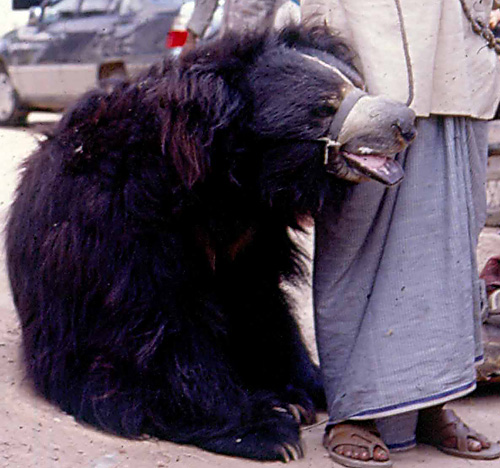Bear necessities: International conference highlights need to eradicate illegal trade in wild bears
New Delhi, India, 30th November 2012—The real life counterpart of Rudyard Kipling’s Baloo faces severe pressure from illegal trade and strong enforcement efforts are needed to protect wild bears in Asia, delegates to an international conference on bear conservation were told.

More than 300 experts from 37 countries gathered in India at the 21st Conference of the International Bear Association held from 26-30th November 2012, to discuss a wide range of bear conservation, research and management issues.
Asia’s bears are of special concern as demand for their parts for use in traditional medicines has increasingly become a serious threat to the conservation of these species. The illegal trade in bear bile and other bear products was highlighted by TRAFFIC and others, with the threats to Asia’s wild bear species being of extreme concern.
In 2011, TRAFFIC launched Pills, powders, vials and flakes: The bear trade in Asia, a report based on an investigation of the trade in bear parts across 13 countries and territories in South-East and East Asia. The report found evidence of widespread illegal sourcing and trade in wild bears and recommended increased efforts to enforce national laws, and better implement the Convention on International Trade in Endangered Species of Wild Fauna and Flora (CITES) in the region.
“Efforts to shut down the illegal trade in bear parts in Asia are essential,” Dr Chris R Shepherd, TRAFFIC’s Deputy Director in South-East Asia, told conference delegates.
“In parallel to increasing enforcement efforts, it is important that steps are taken to reduce demand for bear products, through raising the awareness of laws and conservation issues, and through the promotion of legal herbal and synthetic alternatives to bear bile amongst traditional medicine users.”
“One of the greatest obstacles is the lack of awareness and concern amongst the public and relevant authorities regarding the wide range of threats to bear conservation around the world.”
The conference saw the release of the first “National Bear Conservation and Welfare Action Plan 2012” by the Ministry of Environment and Forests, India, which was officially launched by the Honorable Indian Environment Minister, Mrs Jayanthi Natarajan.
TRAFFIC was encouraged by the Minister’s commitment to increase efforts to safeguard the four species of bears found in India.
Conference delegates also heard about the remarkable change in attitude towards bears in India, with the trade in Sloth Bears for roadside performances all but eliminated for example. However, challenges still exist in India, including human-bear conflict issues, habitat loss and persistent poaching for illegal trade – all issues flagged as serious concerns in the National Bear Conservation and Welfare Action Plan.
The recent IUCN resolution concerning the threat to wild bear populations and their conservation was also presented at the conference. Among other things, the resolution calls for the closure of all illegal bear bile farms in Asia.
More than 100 papers were presented at the conference on diverse aspects of bear research, conservation and welfare, from global warming affecting Polar Bears in Canada, to the widespread illegal use of snares in Lao PDR, to the continuing trade in bear bile products in Malaysia, to rehabilitation efforts for Sloth Bear kalandars in India.
The 21st International Conference on Bear Research and Management was organized jointly by the International Bear Association, Ministry of Environment and Forests, Central Zoo Authority of India, the IUCN SSC Bear Specialist Group, Wildlife Institute of India, Wildlife Trust of India, World Society for the Protection of Animals and the International Fund for Animal Welfare.
Notes:
1. There are four species of bears found in India—Himalayan Brown Bear Ursus arctos isabellinus Himalayan Black Bear Ursus thibetanus; Sun Bear Ursus malayanus; Sloth Bear Melursinus ursinus. All bears found in India are listed in Appendix I of CITES and in Schedule I and II of the Wildlife Protection Act as amended in 2003. Source : National Bear Conservation and Welfare Action Plan 2012.
2. TRAFFIC, the wildlife trade monitoring network, is a strategic alliance of WWF, the global conservation organization and IUCN, the International Union for the Conservation of Nature. TRAFFIC works on wildlife trade issues worldwide. In India, TRAFFIC functions as a division of WWF-India. TRAFFIC India works to ensure that trade in wild plants and animals is not a threat to the conservation of nature in India.

